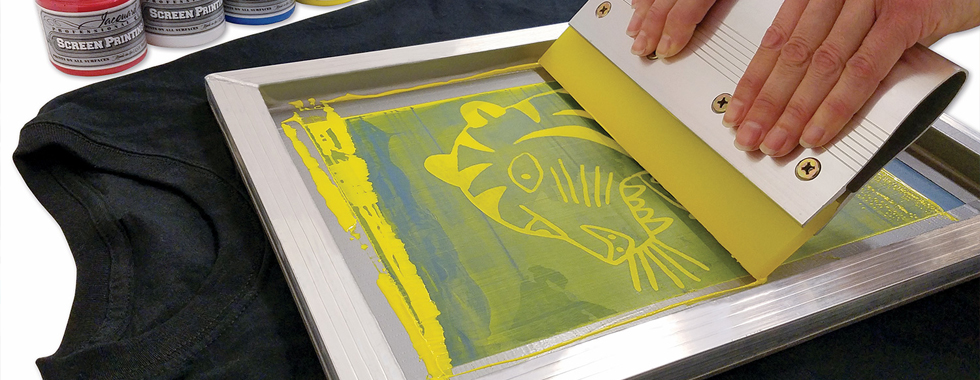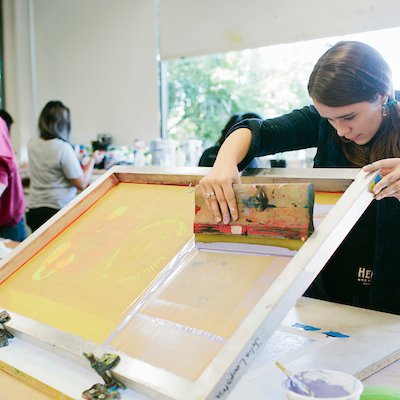ChatGPT said: The ultimate guide to 10:9 Design Screen Printing Texas for businesses and individuals
Discover the Different Kinds Of Screen Printing Techniques for Your Following Task
Screen printing uses a varied series of methods that can improve any kind of imaginative task. From conventional approaches like serigraphy to contemporary advancements such as direct-to-garment printing, each technique has its unique benefits. Specialized options, including environmentally friendly and metal inks, present even a lot more opportunities. Recognizing these techniques can greatly affect the final outcome. The difficulty exists in selecting the most appropriate technique for certain needs and preferred effects. What factors should one consider?

The Basics of Screen Printing
Although screen printing might seem facility, it is fundamentally an uncomplicated process that involves transferring ink through a mesh screen onto various surfaces. The method begins with the development of a stencil, which defines the style to be printed. This stencil is affixed to a mesh screen, commonly constructed from polyester or nylon. When the stencil remains in location, ink is used to the screen and pressed with the mesh making use of a squeegee, causing the desired pattern being printed on the underlying product.
Screen printing can be performed on a wide variety of substrates, consisting of paper, plastic, and fabric, making it a flexible selection for various tasks. The process enables for vivid colors and detailed styles, making it prominent in markets such as advertising, art, and fashion. Comprehending these basics equips individuals with the fundamental expertise called for to discover more sophisticated techniques in screen printing.
Conventional Screen Printing Techniques
Conventional screen printing methods have actually been used for centuries, protecting the workmanship and creativity of this approach. This method makes use of a mesh screen to transfer ink onto a substratum, such as textile or paper, permitting vibrant and resilient layouts. The process begins with creating a stencil, which blocks certain areas of the screen to regulate where the ink will be applied.
One prominent method is serigraphy, often used for minimal editions and creative prints. An additional is the usage of water-based inks, which are environment-friendly and provide a soft feeling on fabrics - 10:9 Design Texas. Additionally, typical methods can include manual printing, where craftsmens apply ink with a squeegee, ensuring accuracy and attention to detail
These methods stay valued in the market for their tactile top quality and the one-of-a-kind structures they generate, attracting both consumers and developers who value the heritage of screen printing.
Digital Screen Printing Innovations
As the demand for faster production and customization in the printing market has actually surged, digital screen printing technologies have emerged as a game-changer. This modern technology mixes typical screen printing techniques with digital procedures, permitting for fast prototyping and intricate styles that were previously challenging to attain. One substantial advancement is the intro of direct-to-garment (DTG) printing, which promotes top quality, full-color prints on various textiles without the demand for screens. Furthermore, improvements in ink formulas have actually led to eco-friendly options that preserve lively colors while minimizing environmental effect. The usage of automated systems better streamlines production, decreasing labor prices and enhancing precision. These advancements not just satisfy little batch orders and customized designs yet likewise permit quicker turnaround times, making them excellent for services concentrated on conference consumer needs in a hectic market. Digital screen printing, as a result, stands for an important evolution in the domain name of printing strategies.
Specialized Screen Printing Techniques
Discovering specialized screen printing techniques reveals a varied array of methods that press the limits of creative thinking and functionality in the printing market. Amongst these, glow-in-the-dark inks offer an one-of-a-kind visual impact, making designs come to life in low-light problems. Metallic inks, known for their sparkling finish, add a touch of luxury to printed products. An additional ingenious technique is discharge printing, which eliminates color from the material as opposed to including ink, causing a soft, vintage feeling. High-density printing produces an increased appearance on the surface area, improving responsive interaction. other Furthermore, water-based inks are acquiring appeal for their vibrant colors and minimized ecological impact. Each of these specialty strategies caters to particular style needs, allowing musicians and brands to create standout items that resonate with their target markets. By leveraging these approaches, businesses can raise their screen printing tasks to brand-new heights, making certain unforgettable impacts.
Eco-Friendly Screen Printing Options
Green screen printing options are obtaining grip as the sector shifts towards sustainability. Sustainable ink options and making use of naturally degradable products are key elements in minimizing the ecological effect of the printing process. By taking on these methods, screen printers can add to a more sustainable future while maintaining top quality results.
Lasting Ink Options

Biodegradable Materials Usage
As the screen printing market progresses, the unification of naturally degradable materials is ending up being increasingly essential for environmentally mindful practices. Producers and developers are now discovering inks and substrates made from all-natural, renewable sources that decay a lot more effectively than standard equivalents. These eco-friendly alternatives lower plastic waste and decrease ecological effect, straightening with the expanding demand for sustainable items.
Common instances include water-based inks and natural cotton materials, both of which reduce dangerous chemicals and promote eco-friendliness. Brands that embrace these products frequently boost their market appeal, drawing in consumers that prioritize sustainability. As understanding of ecological problems remains to rise, the shift towards eco-friendly products in screen printing is most likely to gain energy, fostering a greener sector requirement.
Selecting the Right Technique for Your Project
Just how can one figure out the most suitable screen printing technique for a specific job? The decision hinges on a number of aspects, consisting of the product to be published on, the intricacy of the style, and the preferred manufacturing volume - 10:9 Design LLC Company. Direct-to-garment printing is perfect for elaborate layouts with various shades, try this while typical screen printing excels for bigger runs of less complex graphics.
Additionally, factor to consider of the end-use of the printed item is necessary. For outside applications, strategies that provide resilience and climate resistance, such as plastisol ink, may be liked. Conversely, environmentally-conscious projects might gain from naturally degradable materials or water-based inks.
Ultimately, understanding the project's distinct demands permits for an enlightened selection, ensuring both aesthetic charm and useful long life. By assessing design intricacy, product compatibility, and manufacturing scale, one can effectively choose the most suitable screen printing strategy to satisfy their project's objectives.
Often Asked Questions
What Is the Background of Screen Printing?
Screen printing came from ancient China around 1000 ADVERTISEMENT, advancing with Japan and Europe. By the 20th century, it came to be preferred in commercial art and style, changing exactly how layouts were generated and try this dispersed globally.

Exactly how Do I Prepare Art Work for Screen Printing?
To prepare artwork for screen printing, one should assure high resolution, use a suitable color mode, produce separate layers for each and every color, and transform message to details, guaranteeing compatibility with the printing procedure and preferred result.
What Materials Are Ideal for Screen Printing?
The ideal products for screen printing consist of top notch inks, long lasting screens, and ideal substratums like cotton, polyester, or blends. In addition, utilizing proper emulsion and squeegees can boost the printing procedure and results.
Can I Screen Publish in your home?
Yes, screen printing in the house is feasible. With the appropriate materials, setup, and strategies, individuals can create top quality prints. However, careful consideration of office and tools is important for successful outcomes.

What Are Usual Blunders in Screen Printing?
Common mistakes in screen printing consist of incorrect direct exposure times, inadequate ink consistency, misalignment of displays, not enough cleansing of products, and ignoring to check prints. These mistakes can compromise the quality and precision of the last item.
Screen printing might seem complicated, it is basically an uncomplicated process that entails moving ink through a mesh screen onto various surfaces. As the need for faster manufacturing and personalization in the printing sector has surged, digital screen printing innovations have actually emerged as a game-changer. Exploring specialty screen printing techniques exposes a diverse array of techniques that press the boundaries of imagination and capability in the printing industry. The best products for screen printing include high-grade inks, durable displays, and suitable substrates like cotton, polyester, or blends (10:9 Design LLC Company). Usual errors in screen printing consist of improper direct exposure times, inadequate ink uniformity, misalignment of screens, inadequate cleaning of products, and disregarding to evaluate prints